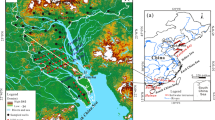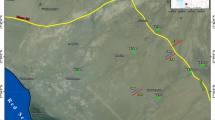Abstract.
Vertical electrical sounding (VES) and hydrochemical data have been used to examine the extent of saltwater intrusion into shallow aquifers (depth<300 m) beneath the coastal plains of southeastern Nigeria underlain by siliciclastic sedimentary rocks of the Cenozoic Niger Delta. The VES data indicate that the coastal regions not affected by saltwater are characterised by K-and H-type geoelectrical curves and models in which high-layer resistivities (in excess of about 100 ohm-m) reflect the presence of freshwater aquifers at depths greater than 5 m below the surface. By contrast, Q-type curves and models denote saltwater-infiltrated islands with the upper boundary of the saline zone at depths of about 25 to 30 m. Chemical analysis results of precipitation and ground water show that, compared to coastal and continental sites, island localities have higher concentrations of major ions (Na+, K+, Ca2+, Mg2+, Cl–, HCO3 –, SO4 2–, NO3) due to saltwater intrusion. In addition, these ions, which also characterise seawater, show very good correlations (>0.70). Furthermore, the coastal sites are marked by Ca-Cl and Ca-HCO3 water types whereas Na-Cl dominated both the islands ( at depths greater than 20 m) and the seawater. This gives an indication of seawater contamination. Seawater contamination is also indicated by the results of five assessment parameters as follows: high chloride concentration (>500 mg/l), high saturation index (halite>10–6), high ionic strength (>0.05), low formation resistivity (<25 ohm-m), and low formation factor (<0.05). Two of these parameters (chloride concentration, ionic strength) have been used to compose an assessment scheme with five major classes (AA, BB, CC, DD, EE) corresponding to various degrees of salinity. Generally in the study area, saltwater contamination is a feature of island locations at depths greater than about 20 m. Water within the inland coastal regions is fresh.
Similar content being viewed by others
Author information
Authors and Affiliations
Additional information
Electronic Publication
Rights and permissions
About this article
Cite this article
Edet, .A., Okereke, .C. A regional study of saltwater intrusion in southeastern Nigeria based on the analysis of geoelectrical and hydrochemical data.. Env Geol 40, 1278–1289 (2001). https://doi.org/10.1007/s002540100313
Received:
Accepted:
Issue Date:
DOI: https://doi.org/10.1007/s002540100313




